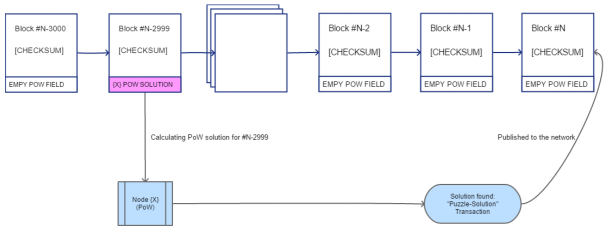Optional PoW - Mining
Introduction
During the start up of the Ixian project, a large amount of currency must be generated quickly and awarded to the most active participants. A pre-mined amount would partially solve this problem, but the distribution relies too much on the Ixian team’s discretion and does not inspire confidence. The pre-mine amount has therefore been kept relatively small and an additional, temporary way was created to allow the community to generate their own currency.
Mining in Ixian is optional for the first five years of operation, after which it will be switched off and new PoW solutions will no longer be accepted by Master Nodes. This document provides a technical description of how the Ixian’s optional PoW algorithm works.
Technical Implementation
Active History
Because Ixian DLT is a redacted blockchain, the entire block history is not saved with every node, but only on a few ‘Full History Nodes’. The part of the blockchain, which must be held in memory by each participating node is called the ‘Active History’, and can be dynamically determined by the network after a suitable algorithm is decided. The default window for the “Active History” (called the “Redacted Window Size”), is 7 days (20000 blocks).
Blank Proof-of-Work field
Each block in the chain includes a field for a possible Proof-of-Work solution. This space consists of a solution to the block puzzle and a signature from the node which has calculated the challenge. Block signatures are still sufficient for validating the transactions in the block. The blank PoW solution field is not included in the verifying signature for the block, which means that the PoW field can be changed at any time. A simplified chain with the blank PoW field is represented below:

Transaction Type: Puzzle-Solved
A new transaction type is introduced for the Proof-of-Work operations. This transaction consists of a PoW solution for any block, which is present in the Active History at the moment when the transaction is processed, as shown in the image below.

The targeted block must currently have no solution for the PoW puzzle. Once this transaction is verified by a DLT node and the containing block is accepted by the network, the details are added to the Active History into the blank PoW field. That block now has a filled PoW field, and is confirmed by a transaction in an accepted block. Based on this, new currency is generated and awarded to the node which calculated the puzzle.
Graphical representation of the PoW award process:

Solution Details - Technical
The PoW solution is formed in the following manner:

Where PoW is the solution to the PoW problem using the “Argon2ID” hashing functions, whose input message, called “pwd” in the reference Argon implementation is the combination of the target block checksum - BlockChecksum - and the address of the walled which will receive the reward for solving the puzzle - SolverAddress. The solution is found by inserting a random, 128-bit value as Nonce, until a hash is found which meets certain criteria based on the difficulty Block parameter.
Difficulty Adjustments
Because new nodes join the network and start searching for the PoW solution, while other nodes stop, the difficulty must be adjusted to reflect the current network’s total hashing power. If the difficulty is too easy, too many Blocks will have their PoW solution. Conversely, if the difficulty is too high, too few Blocks will be solved. The difficulty should be selected such, that roughly 50% of all Blocks in the active history are solved before they are redacted.
The Block difficulty is an 8-byte unsigned integer, which represents the characteristic of the PoW solution value to which a valid solution must conform. In Ixian, the entire solution range (a solution is a 256-bit number) is split into 2^64 sub-ranges. The difficulty number, being a 64-bit unsigned integer, selects one of the sub-ranges, which is interpreted as the absolute ceiling. A valid PoW solution must be numerically below the chosen ceiling.
In order to convert the difficulty number into a ‘hash-ceiling’, the following method is used:
- A bitwise inverse of the difficulty value is calculated (one’s complement)
- A zero-value, 256-bit number is generated.
- Bits from the inverted difficulty are inserted into the empty 256-bit number at bit positions 13 - 76 (bit 1 is the most significant bit).
- Bits before the inserted value are set to zero.
- Bits after the inserted value are set to one.
The resulting hash-ceiling value represents the upper limit of the 256-bit PoW solution. Solutions, which are numerically less than the hash-ceiling are considered valid for the given difficulty.
The exact distribution of the sub-ranges allow Ixian to set a wide range of difficulties. In order to prevent some possible exploits, a lower limit has been set on the difficulty value. The lowest possible difficulty is therefore defined to be 0xA2CB1211629F6141, which equates to (on average) 180000 hashes required in order to find a valid solution. The number can be achieved by 10 miners, with 300 H/s each - this was defined as an approximation of the minimum network size. With the total hashing power of 3000 H/s, a block solution should be found approximately every 60 seconds. Since the blocks are generated at 30-second intervals, the resulting solution ratio should be near 50%.
Upper bound on the difficulty is not specified, so the theoretical maximum difficulty could be 0xFFFFFFFFFFFFFFFF, which would require 1.15 zetta-hashes on average to find a block solution. This number was deemed sufficiently large. It would require about 16 quintillion miners at 1200 H/s each) to keep up with the 50% solution ratio.
